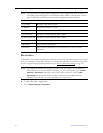
Administration
ETV Portal Server Administrator Guide 29
a. For MPEG devices, select a Parameter Name from the dropdown, enter a Parameter
Value
, and click Add. Repeat as many times as necessary and click Submit when
done. Note that the order in which you add parameters is critical. This is the order in
which they will be executed at runtime.
b. For non-MPEG (Other) devices, write the script in a native language compatible with
the device and click
Submit when done.
URLs
Add/Modify a URL for a Live Video Stream
Administrators can manually enter URLs to live video streams that will not automatically be
displayed by the Portal Server. For example, the administrator may wish to have the
Announcements (SAPs) disabled on the VBrick encoders for security purposes. Or the
Administrator may want to enter the address of an off-network stream such as an MPEG-4
Stream from an Apple Darwin Server or a stream coming from a hosting provider.
Additionally, this feature leys you enter the addresses of non-MPEG streams such as
Windows Media and Real streams. Note that the Access Control feature Allow Viewing by
Content Type does not apply to manually added URLs.
The following examples show valid URL syntax for live video streams. The syntax must be
accurate and there is no internal validation of user input:
Valid for Types MPEG-1 and MPEG-2
vbricksys://ip=239.1.1.1&port=4444
Where 239.1.1.1 is the multicast IP address and 4444 is the multicast port.
Valid for Type MPEG-4
rtsp://172.1.1.1/vbrickvideo1
vbrtsp://172.1.1.1/vbrickvideo1
Where 172.1.1.1 is the source IP address and vbrickvideo1 is the program name.
vbhttp://172.1.1.1/vbs2d1.sdp
Where 172.1.1.1 is the source IP address and vbs2d1.sdp is the SDP file name.
Valid for Type Other
ASX Files
http://172.1.1.1/file.asx
http://myHost/file.asx
http://www.myCompany.com/files/file.asx
MP3 and WMA Files
http://172.1.1.1/file.mp3
http://myHost/file.mp3
Note For any non-MPEG video, the correct player (such as Windows Media Player or
Real Player) must be present on the desktop for the client to be able to receive the
stream. Set Top Boxes will not be able to receive non-MPEG streams because the
Set Top Box only includes decoders for MPEG-1, MPEG-2, and MPEG-4.


















